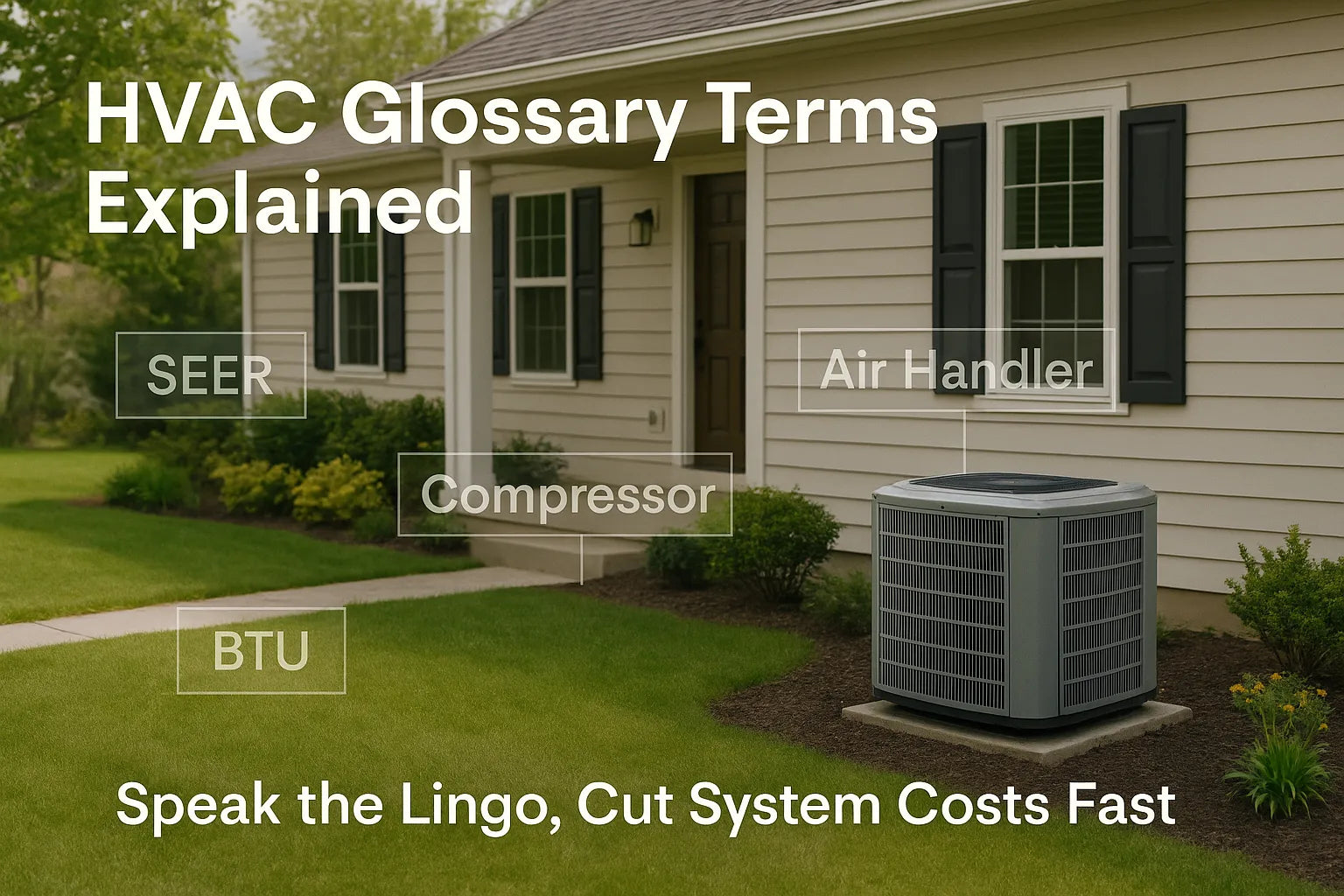Why Learning HVAC Language Pays Off
Imagine your contractor rattling off acronyms while you nod along, hoping the final price makes sense. Knowing key HVAC terms replaces that uneasy nod with confident questions and savings. When you can compare SEER ratings or ask about the compressor warranty, upsells shrink and smart choices grow.
Homeowners we work with at The Furnace Outlet routinely cut 10–15 % off bids just by showing they understand the basics. Think of this glossary as your translator, turning tech-speak into clear next steps for comfort, budget, and long-term value.
HVAC as a Whole: How the Pieces Work Together
Your system is more than a furnace and an outdoor box. Heating, Ventilation, and Air Conditioning (HVAC) is a loop: air moves through return ducts, gets filtered, heated or cooled, then recirculates through supply ducts. Each component filter, air handler, evaporator coil, condenser unit must be sized and matched. Mismatched parts start the “domino effect” of frequent repairs. If you’re shopping for a complete upgrade, compare bundled package units; the factory-matched components simplify installation and warranty coverage.
Filters: Small Part, Huge Difference
A $10 filter can protect a $10,000 system. Its job is simple: trap dust before air flows across sensitive coils. Clogged filters starve airflow, making the blower work harder and the evaporator coil freeze. Replace every 1–3 months; mark it on your phone calendar, not “when it looks dirty.” If you own rental properties, gifting tenants a year’s supply of filters is cheaper than an emergency call-out.
Stock up in the accessories section so you always have the right size on hand.
Thermostats & Controls: Brains of the Operation
A thermostat is the only HVAC part you actually touch, yet it directs everything else. Programmable and Wi-Fi models learn patterns lowering the setpoint when the house empties, nudging it up before you return. Studies show smart scheduling shaves 8–12 % off annual bills. Check that any new stat is compatible with heat-pump logic or multi-stage gas furnaces before you click “buy.” Not sure? The Furnace Outlet’s Help Center can confirm wiring in minutes.
Refrigerant Reality Check
Refrigerant is the bloodstream of cooling. Leaks turn into higher electric bills and in older R-22 systems pricey recharge costs. Modern units use eco-friendlier R-32 blends. When replacing an aged condenser, look at R32 residential air-conditioner condensers; they deliver the same comfort with lower greenhouse impact and may qualify for local rebates. Ask your tech to weigh the charge rather than “eyeballing” with sight-glass bubbles—precision matters.
Coils & Compressor: The Cooling Cycle in Plain English
Picture your air-conditioner as a relay race:
-
Evaporator coil inside soaks up house heat as refrigerant boils.
-
The compressor outside squeezes that hot vapor to raise its temperature further.
-
The condenser coil releases the heat outdoors, turning vapor back to liquid.
Dirty coils inside or out add 20 % runtime. A gentle garden-hose rinse each spring protects efficiency. When coils corrode, swapping to a matched set from our R32 AC and coil line avoids the compatibility headaches of piecing brands together.
BTU, Load, and Why Size Really Matters
Heating and cooling capacity is measured in BTUs. Too small and the unit never stops; too large and it short-cycles, leaving clammy rooms. A proper load estimate factors square footage, insulation, window orientation, and local climate. Skip the rule-of-thumb guesses our free Design Center calculator outputs a room-by-room report you can hand to any installer. Matching BTU to the load not only cuts power bills but can add five years to equipment life.
Efficiency Numbers: SEER, AFUE, and Your Power Bill
Efficiency boils down to one question: How much comfort do you squeeze from every energy dollar? SEER rates cooling; AFUE rates gas heating. A jump from SEER 13 to SEER 16 saves roughly $300 a year on a 2,000 sq ft home often paying back the upgrade in under four summers. When browsing, compare systems side-by-side and check our Lowest Price Guarantee; it protects your budget if a local supplier offers the same model for less.
Heat Pumps, Mini-Splits, and Duct Decisions
Not every building needs a full ducted setup. Heat pumps both heat and cool by moving heat, not making it ideal for moderate climates or as a gas-furnace backup. Older homes without ducts may favor ductless mini-split options; each indoor head creates its own zone, slashing arguments over bedroom temperatures.
Pair mini-splits with a ceiling-mounted air handler when some rooms still rely on ductwork hybrid setups are common in attic conversions.
Partnering with Pros and Avoiding Costly Pitfalls
Even armed with glossary knowledge, lean on licensed pros for permits, refrigerant handling, and warranty validation. Ask installers for model numbers in writing, proof of EPA refrigerant certification, and a copy of the load calculation. Before you sign, cross-check availability and price on The Furnace Outlet site often you can provide the equipment and let the contractor handle labor.
Need guidance fast? Hit Contact Us; experienced techs answer within one business day, no purchase required.
Field-Tested Tips
-
Change filters on the first day of every odd month—easy to remember, easy to breathe.
-
Label breakers for furnace, compressor, and air handler; it saves panic during storms.
-
Keep clearance: two feet of open space around the outdoor condenser for proper airflow.
-
Document serial numbers in your phone; warranty claims go smoother.
-
Book spring and fall tune-ups; skipping one can void efficiency rebates.







